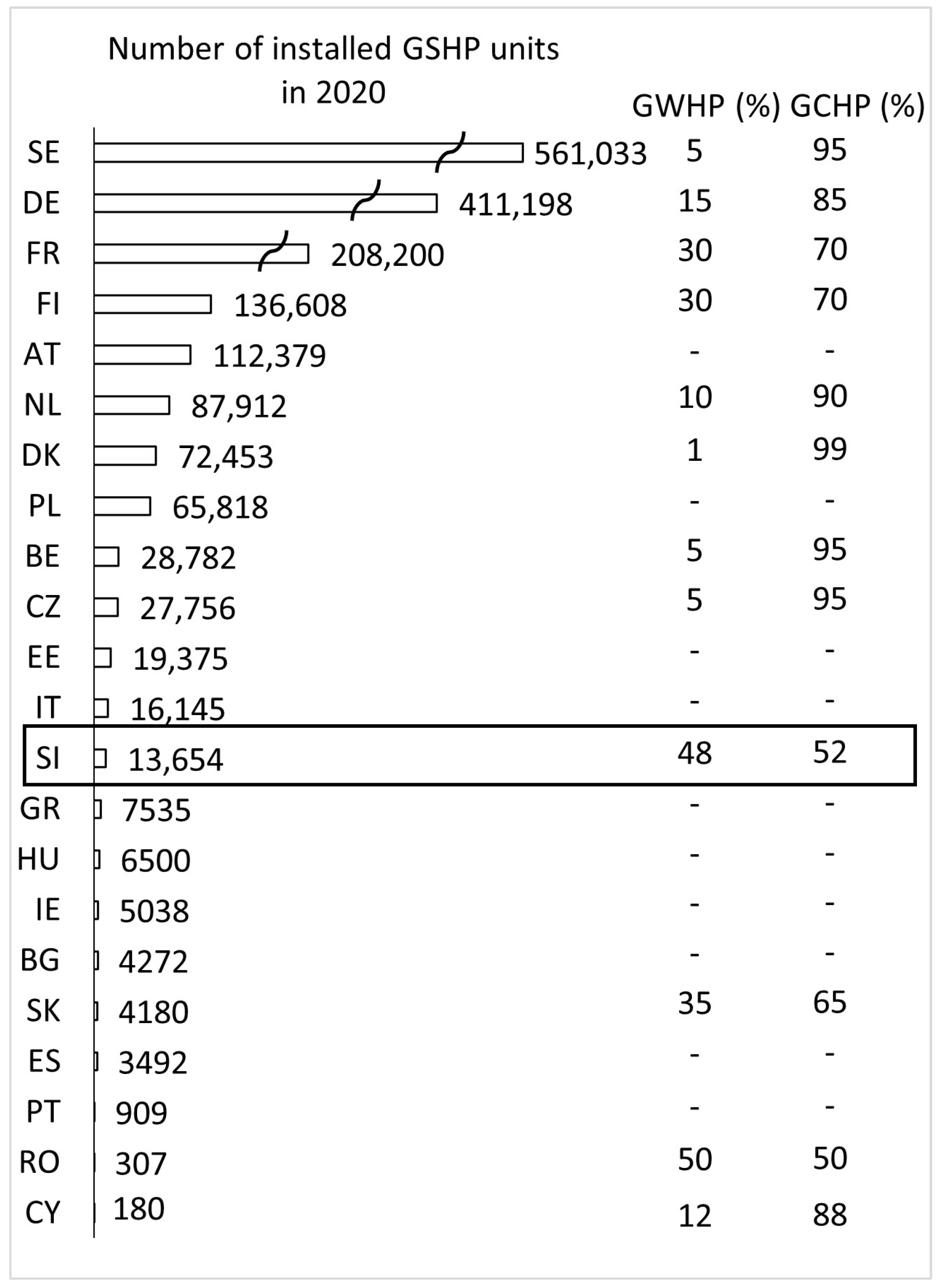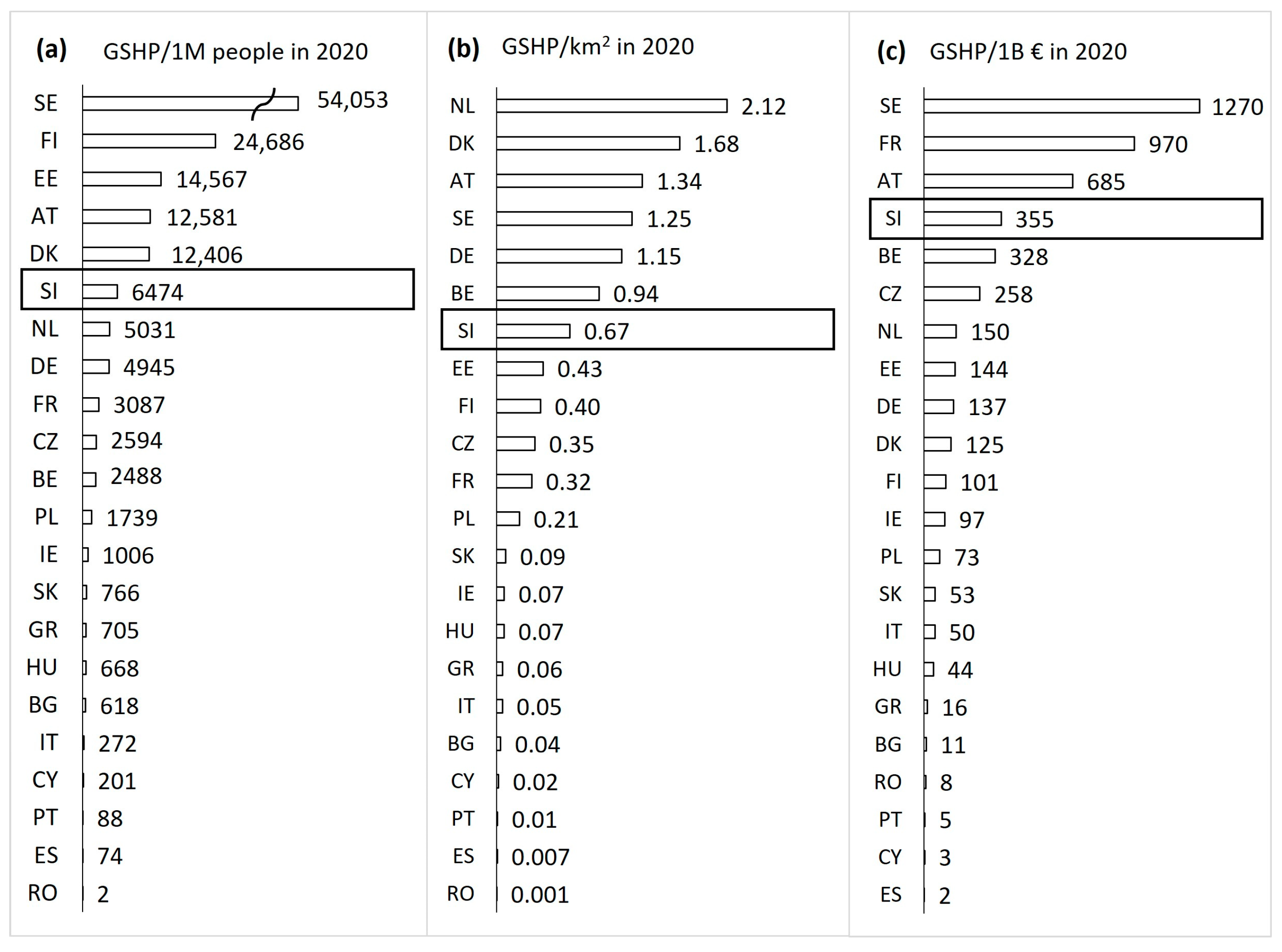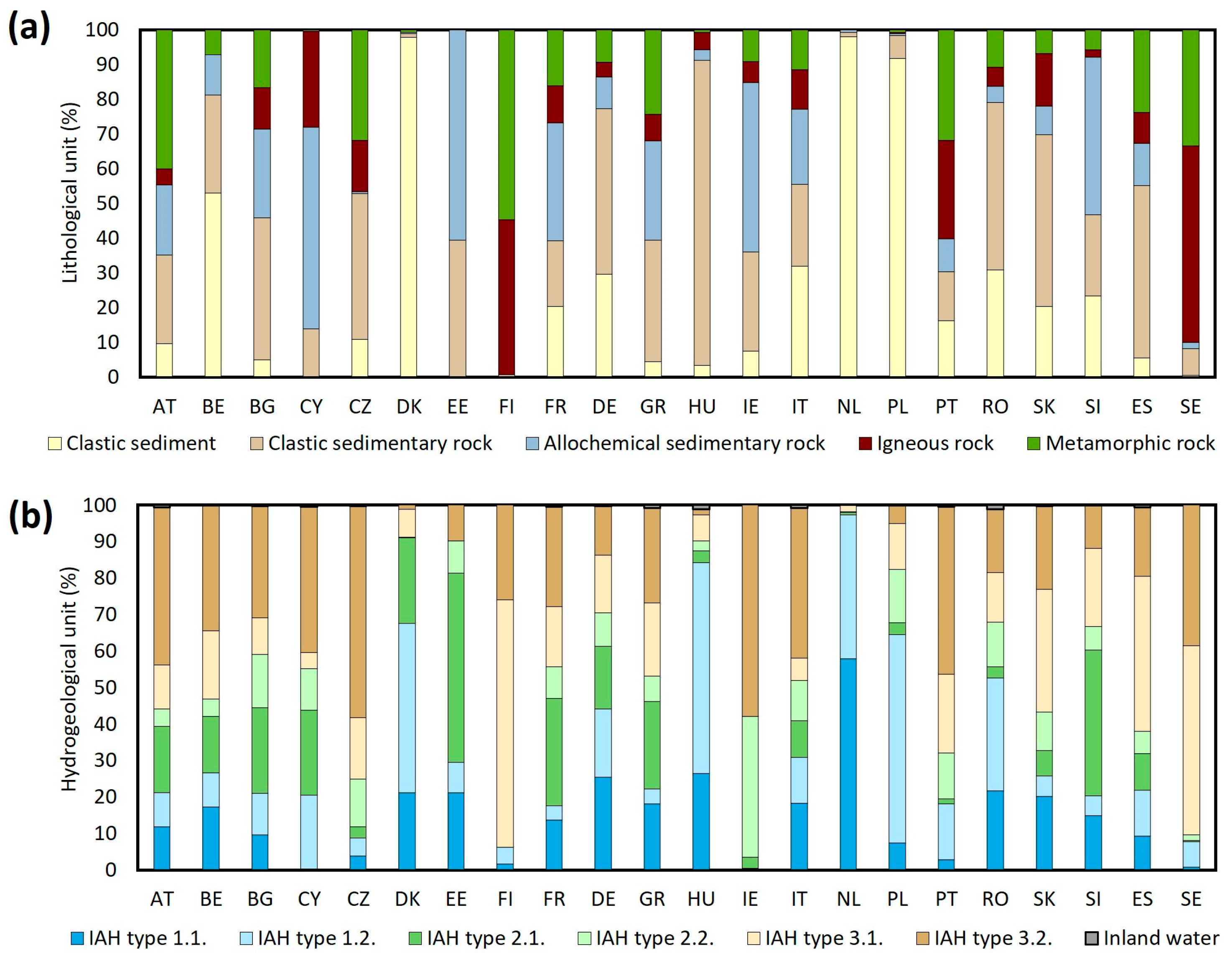Influence of Geology, Hydrogeology, and Climate on Ground Source Heat Pump Distribution in Slovenia and Selected European Countries
Abstract
:1. Introduction
2. Materials and Methods
2.1. Study Area
2.2. Sales Figures of GSHP Systems in Slovenia
2.3. Data Compilation
2.3.1. Slovenia
2.3.2. European Countries
2.4. Spatial Distribution
2.5. Statistical Analysis
2.5.1. χ2 Test
2.5.2. Information Value Method
3. Results
3.1. χ2 Test
3.2. Information Value Method
3.3. Analysis of Installed GSHP in Selected EU Countries
4. Discussion
5. Conclusions
- In Slovenia, there is a database of GWHP systems, while GCHP systems are not systematically collected. In the future, an increase in the spatial density of GSHP systems is expected due to the transition to renewable energy sources; thus, more systematic collection, better maintenance, and easier access to information on GCHP systems will be needed.
- To our knowledge, the two quantitative statistical methods used in the study, the χ2 test and the information value method (, were applied to the GSHP system data for the first time.
- The statistical results showed the predominant influence of hydrogeological conditions on the spatial distribution of GSHP systems in Slovenia.
- The shares of GCHP (51%) and GWHP (49%) systems installed in Slovenia in the time interval 2016–2021, registered in the Eco Fund database, are comparable. The share of GWHP systems is among the highest in European countries.
- The share of GCHP systems in the analysed European countries strongly prevails (on average, 86.5%), even though natural conditions are favourable for ground heat pumps. This is typical also for countries where the geological and hydrogeological conditions are similar to those in Slovenia (e.g., DK, FR, DE). The high share of GCHP systems is related to the stricter regulations for the installation of GWHP systems and natural conditions in these countries. In Slovenia, the high share of installed GWHP systems is related to the favourable hydrogeological conditions that allow the drilling of shallow wells, which makes the investment cheaper, although the regulations for these systems are stricter.
Author Contributions
Funding
Data Availability Statement
Acknowledgments
Conflicts of Interest
References
- Banks, D. An Introduction to Thermogeology: Ground Source Heating and Cooling, 2nd ed.; Wiley-Blackwell: New York, NY, USA, 2012. [Google Scholar] [CrossRef]
- EGEC. Geothermal Market Report 2020; European Geothermal Energy Council: Brussels, Belgium, 2021. [Google Scholar]
- European Council. EU Directive 2018/2001 of the European Parliament and of the Council of 11 December 2018 on the Promotion of the Use of Energy from Renewable Sources; 02018L2001-20220607; European Council: Brussels, Belgium, 2018. [Google Scholar]
- Lund, J.W. Ground-Source (Geothermal) Heat Pumps. In Proceedings of the Heating with Geothermal Energy: Conventional and New Schemes. World Geothermal Congress, Kazuno, Japan, 28 May–10 June 2000; pp. 209–236. [Google Scholar]
- Stauffer, F.; Bayer, P.; Blum, P.; Molina-Giraldo, N.; Kinzelbach, W. Thermal Use of Shallow Groundwater; Taylor & Francis Group: Abingdon, UK, 2014. [Google Scholar]
- Sass, I.; Brehm, D.; Coldewey, W.G.; Dietrich, J.; Klein, R.; Kellner, T.; Kirschbaum, B.; Lehr, C.; Marek, A.; Mielke, P.; et al. Shallow Geothermal Systems—Recommendations on Design, Construction, Operation and Monitoring; Wilhelm Ernst & Sohn: Berlin, Germany, 2016. [Google Scholar]
- De Moel, M.; Bach, P.M.; Bouazza, A.; Singh, R.M.; Sun, J.O. Technological advances and applications of geothermal energy pile foundations and their feasibility in Australia. Renew. Sustain. Energy Rev. 2010, 14, 2683–2696. [Google Scholar] [CrossRef]
- Chiasson, A.D. Geothermal Heat Pump and Heat Engine Systems—Theory and Practice; Wiley: Dayton, OH, USA, 2016. [Google Scholar]
- Kłonowski, M.; Kozdrój, W.; Götzl, G.; Heiermann, M. Summary Report on Existing Energy Planning Strategies in the EU Considering the Use of Shallow Geothermal Energy; Project GeoPLASMA-CE, D.T4.1.3; Polish Geological Institute—National Research Institute: Warsaw, Poland, 2018; p. 23. [Google Scholar]
- European Council. EU Directive 2023/2413 of the European Parliament and of the Council of 18 October 2023 Amending Directive (EU) 2018/2001, Regulation (EU) 2018/1999 and Directive 98/70/EC as Regards the Promotion of Energy from Renewable Sources, and Repealing Council Directive (EU) 2015/652; 32023L2413; European Council: Brussels, Belgium, 2023. [Google Scholar]
- Sikora, A. European Green Deal—Legal and financial challenges of the climate change. ERA Forum 2021, 21, 681–697. [Google Scholar] [CrossRef]
- European Council. Communication on REPowerEU: Joint European Action for More Affordable, Secure and Sustainable Energy; COM, 108 Final; European Council: Brussels, Belgium, 2022. [Google Scholar]
- Ministry of Infrastructure. Integrated National Energy and Climate Plan of the Republic of Slovenia; Ministry of Infrastructure: Ljubljana, Slovenia, 2020; p. 233. [Google Scholar]
- European Commission. Assessment of the Final National Energy and Climate Plan of Slovenia; European Commission: Brussels, Belgium, 2020; p. 27. [Google Scholar]
- Lund, J.W.; Toth, A.N. Direct utilization of geothermal energy 2020 worldwide review. Geoth 2021, 90, 101915. [Google Scholar] [CrossRef]
- EGEC. Geothermal Market Report 2022; European Geothermal Energy Council: Brussels, Belgium, 2023. [Google Scholar]
- Eurostat. Greenhouse Gas Emissions Per Capita in 2021. Available online: https://ec.europa.eu/eurostat/databrowser/view/env_air_gge__custom_7976013/default/table?lang=en (accessed on 20 October 2023).
- Eurostat. Population Unable to Keep Home Adequately Warm by Poverty Status in 2022. Available online: https://ec.europa.eu/eurostat/databrowser//product/view/sdg_07_50 (accessed on 20 October 2023).
- Casasso, A.; Sethi, R. Assessment and mapping of the shallow geothermal potential in the province of Cuneo (Piedmont, NW Italy). Renew. Energy 2017, 102, 306–315. [Google Scholar] [CrossRef]
- Garcia-Gil, A.; Schneider, E.; Moreno, M.; Santamarta, J. Shallow Geothermal Energy: Theory and Application; Springer: Cham, Switzerland, 2022. [Google Scholar] [CrossRef]
- Banks, D. The application of analytical solutions to the thermal plume from a well doublet ground source heating or cooling scheme. Q. J. Eng. Geol. Hydrogeol. 2011, 44, 8. [Google Scholar] [CrossRef]
- Al-Khoury, R. Computational Modeling of Shallow Geothermal Systems; Taylor & Francis Group: Abingdon, UK, 2012; Volume 4. [Google Scholar]
- Alcaraz, M.; García-Gil, A.; Vázquez-Suñé, E.; Velasco, V. Use rights markets for shallow geothermal energy management. J. ApEn 2016, 172, 34–46. [Google Scholar] [CrossRef]
- Ramos-Escudero, A.; García-Cascales, M.S.; Cuevas, J.M.; Sanner, B.; Urchueguía, J.F. Spatial analysis of indicators affecting the exploitation of shallow geothermal energy at European scale. Renew. Energy 2021, 167, 266–281. [Google Scholar] [CrossRef]
- Macenić, M.; Kurevija, T.; Strpić, K. Systematic review of research and utilization of shallow geothermal energy in Croatia. Rud. Geol. Naft. Zb. 2018, 43, 1–11. [Google Scholar] [CrossRef]
- Majuri, P.; Arola, T.; Kumpula, A.; Vuorisalo, T. Geoenergy permits in Finnish regional administration—Contradictory practices and inadequate judicial regulation. Renew. Energy 2021, 168, 151–159. [Google Scholar] [CrossRef]
- Water Right Database. Available online: http://www.evode.gov.si/index.php?id=59 (accessed on 10 November 2021).
- Eco Fund. Available online: https://www.ekosklad.si/english (accessed on 17 November 2021).
- Rajver, D.; Rman, N.; Lapanje, A.; Prestor, J. Geothermal Country update report for Slovenia 2015–2019. In Proceedings of the World Geothermal Congress 2020+1, Reykyavik, Iceland, 1 April–1 October 2021. [Google Scholar]
- Yin, K.L.; Yan, T.Z. Statistical Prediction Model for Slope Instability of Metamorphosed Rocks. In Proceedings of the 5th International Symposium on Landslides, Lausanne, Switzerland, 10–15 July 1988; pp. 1269–1272. [Google Scholar]
- van Westen, C.J. Statistical Landslide Hazard Analysis. In ILWIS 2.1 for Windows Application Guide; ITC Publication: Enschede, The Netherlands, 1997; pp. 73–84. [Google Scholar]
- Reichenbach, P.; Rossi, M.; Malamud, B.D.; Mihir, M.; Guzzetti, F. A review of statistically-based landslide susceptibility models. Earth Sci. Rev. 2018, 180, 60–91. [Google Scholar] [CrossRef]
- Rai, P.K.; Nathawat, M.S.; Rai, S. Using the information value method in a geographic information system and remote sensing for malaria mapping: A case study from India. Inform. Prim. Care 2013, 21, 43–52. [Google Scholar] [CrossRef]
- Novak, M. Lithological Composition. In Geological atlas of Slovenia, 2nd ed.; Novak, M., Rman, N., Eds.; Geological Survey of Slovenia: Ljubljana, Slovenia, 2018. [Google Scholar]
- Prestor, J.; Meglič, P. Hydrogeological Map. In Geological Atlas of Slovenia, 2nd ed.; Novak, M., Rman, N., Eds.; Geological Survey of Slovenia: Ljubljana, Slovenia, 2018. [Google Scholar]
- Water Protection Areas. Available online: http://kazalci.arso.gov.si/en/content/water-protection-areas-1 (accessed on 14 July 2021).
- Ogrin, D. Podnebni tipi v Sloveniji. Geogr. Vestn. 1996, 68, 39–56. [Google Scholar]
- Population Density—Municipality. Available online: https://www.stat.si/obcine/sl/Theme/Index/PrebivalstvoGostota (accessed on 21 January 2022).
- Groundwater Archive. Available online: https://vode.arso.gov.si/hidarhiv/pod_arhiv_tab.php (accessed on 14 July 2021).
- Energietechnik, V.F. VDI 4640 Part 2: Thermal Use of the Underground—Ground Source Heat Pump Systems; VDI-Gesellschaft Energie und Umwelt: Dűsseldorf, Germany, 2001; p. 43. [Google Scholar]
- Ciglič, R.; Perko, D. Slovenia in geographical typifications and regionalizations of Europe. Geogr. Vestn. 2012, 84, 14. Available online: https://www.dlib.si/details/URN:NBN:SI:doc-ODYOLIZE (accessed on 20 October 2023).
- Meteo Archive. Available online: https://meteo.arso.gov.si/met/sl/archive/ (accessed on 14 July 2021).
- Rajver, D.; Lapanje, A.; Rman, N.; Prestor, J. Geothermal Energy Use, Country Update for Slovenia. In Proceedings of the European Geothermal Congress 2019, The Hague, The Netherlands, 11–14 June 2019; p. 16. [Google Scholar]
- Rajver, D.; Lapanje, A.; Rman, N.; Prestor, J. Geothermal Energy Use, Country Update for Slovenia. In Proceedings of the European Geothermal Congress 2022, Berlin, Germany, 17–21 October 2022; p. 13. [Google Scholar]
- Rajver, D.; Pestotnik, S.; Prestor, J.; Svetina, J.; Janža, M.; Rman, N.; Lapanje, A. Uveljavljanje Plitve Geotermalne Energije med Drugimi Obnovljivimi Viri Energije za Ogrevanje in Hlajenje; Geological Survey of Slovenia: Ljubljana, Slovenia, 2021. [Google Scholar]
- Heat Pump Barometer 2020; EurObserv’ER: Paris, France, 2021; p. 8.
- Geothermal Energy Use, Country Updates. In Proceedings of the World Geothermal Congress 2020+1, Reykjavik, Iceland, 1 April–1 October 2021.
- ESRI. ArcGIS Desktop: Release 10.7.1; Environmental Systems Research Institute: Redlands, CA, USA, 2019. [Google Scholar]
- Struckmeier, W.; Margat, J.F. Hydrogeological Maps: A Guide and a Standard Legend; Heise: Hannover, Germany, 1995. [Google Scholar]
- USGS. Generalized Geology of Europe Including Turkey. Available online: https://data.usgs.gov/datacatalog/data/USGS:60abc880d34ea221ce51e621 (accessed on 27 November 2021).
- International Hydrogeological Map of Europe 1:1,500,000. Available online: https://www.bgr.bund.de/EN/Themen/Wasser/Projekte/laufend/Beratung/Ihme1500/ihme1500_projektbeschr_en.html (accessed on 27 November 2021).
- McKillup, S.; Darby Dyar, M. Geostatistics Explained: An Introductory Guide for Earth Scientists; Cambridge University Press: New York, NY, USA, 2010; p. 414. [Google Scholar]
- List of European Countries by Area. Available online: https://statisticstimes.com/geography/european-countries-by-area.php (accessed on 19 August 2021).
- Eurostat. Population. Available online: https://ec.europa.eu/eurostat/databrowser/view/tps00001/default/table?lang=en (accessed on 20 January 2022).
- Eurostat. Real GDP per Capita. Available online: https://ec.europa.eu/eurostat/databrowser/view/sdg_08_10/default/table?lang=en (accessed on 20 January 2022).
- McHugh, M.L. The chi-square test of independence. Biochem. Medica 2013, 23, 143–149. [Google Scholar] [CrossRef] [PubMed]
- Meinhardt, M.; Fink, M.; Tunschel, H. Landslide susceptibility analysis in central Vietnam based on an incomplete landslide inventory: Comparison of a new method to calculate weighting factors by means of bivariate statistics. Geomo 2015, 234, 80–97. [Google Scholar] [CrossRef]
- Götzl, G.; Dilger, G.; Grimm, R.; Hofmann, K.; Holeček, J.; Černák, R.; Janža, M.; Kozdroj, W.; Hajto, M.; Gabriel, P.; et al. Strategies for Fostering the Use of Shallow Geothermal Energy for Heating and Cooling in Central Europe—Results from the Interreg Central Europe Project GeoPLASMA-CE. In Proceedings of the World Geothermal Congress 2020+1, Reykjavik, Iceland, 1 April–1 October 2021; p. 17. [Google Scholar]
- Mathiesen, A.; Nielsen, L.H.; Vosgerau, H.; Poulsen, S.E.; Bjørn, H.; Røgen, B.; Ditlefsen, C.; Vangkilde Pedersen, T. Geothermal Energy Use, Country Update Report for Denmark. In Proceedings of the World Geothermal Congress 2020+1, Reykjavik, Iceland, 1 April–1 October 2021. [Google Scholar]
- Open of Gesloten Bodemenergie? Available online: https://bodemenergie.nl/open-of-gesloten-bodemenergie/ (accessed on 22 January 2022).
- Arola, T.; Eskola, L.; Hellen, J.; Korkka-Niemi, K. Mapping the low enthalpy geothermal potential of shallow Quaternary aquifers in Finland. Geotherm. Energy 2014, 2, 9. [Google Scholar] [CrossRef]










| Small Units (<20 kW) | Large Units (>20 kW) | Total | |
|---|---|---|---|
| Number of units | 12,853 | 801 | 13,654 |
| GWHP (%) | 46 | 79 | 48 |
| Horizontal GCHP (%) | 38 | 4 | 36 |
| Vertical GCHP (%) | 15 | 17 | 16 |
| Database | Data on Locations | Data Collection Interval (Year) | GWHP (Number) | GCHP (Number) | Total GSHP (Number) |
|---|---|---|---|---|---|
| Eco Fund [28] | yes | 2016–2021 | 1073 | 1122 | 2195 |
| Water rights and Recorded special use of water [27] | yes | 2004–2021 | 2061 | - | - |
| 2016–2021 | 1340 | - | - | ||
| Sales figures [29] | no | 1994–2021 | 6571 | 7083 | 13,654 |
| 2004–2021 | 5851 | 6923 | 12,774 | ||
| 2016–2021 | 2077 | 2222 | 4299 |
| Factor | Area (km2) | Population (Number) | GWHP System | GCHP System | ||||
|---|---|---|---|---|---|---|---|---|
| Number of Units | O–E | χ2 | Number of Units | O–E | χ2 | |||
| Geological class | ||||||||
| Clastic sediment | 6382 | 1,209,150 | 540 | 152 | 59 | 424 | −152 | 40 |
| Clastic sedimentary rock | 3245 | 290,258 | 8 | −41 | 34 | 113 | 41 | 23 |
| Chemical sedimentary rock | 9193 | 494,672 | 59 | −97 | 60 | 329 | 97 | 40 |
| Igneous rock | 602 | 33,629 | 9 | −10 | 5 | 38 | 10 | 3 |
| Metamorphic rock | 851 | 81,268 | 6 | −4 | 2 | 20 | 4 | 1 |
| SUM | 20,273 | 210,8977 | 622 | 0 | 160 | 924 | 0 | 108 |
| Degrees of freedom | 4 | 4 | ||||||
| p-value (two-tailed) | <0.001 | <0.001 | ||||||
| Hydrogeological class | ||||||||
| 1.1. | 1484 | 677,895 | 194 | 124 | 219 | 65 | −124 | 82 |
| 1.2. | 1447 | 122,102 | 63 | −18 | 4 | 233 | 18 | 1 |
| 2.1. | 2064 | 169,056 | 12 | −11 | 5 | 73 | 11 | 2 |
| 2.2. | 7056 | 358,265 | 41 | −24 | 9 | 199 | 24 | 3 |
| 3.1. | 5612 | 472,414 | 36 | −77 | 53 | 380 | 77 | 20 |
| 3.1.1. | 1461 | 114,897 | 14 | −4 | 1 | 51 | 4 | 0 |
| 3.2. | 167 | 33,668 | 0 | −2 | 1 | 7 | 2 | 0 |
| 3.3. | 982 | 160,680 | 36 | 11 | 5 | 57 | −11 | 2 |
| SUM | 20,273 | 210,8977 | 397 | 0 | 296 | 1066 | 0 | 110 |
| Degrees of freedom | 7 | 7 | ||||||
| p-value (two-tailed) | <0.001 | <0.001 | ||||||
| Climate class | ||||||||
| Alpine | 2976 | 267,137 | 10 | −28 | 20 | 68 | 28 | 19 |
| Temperate Continental | 15,636 | 1,695,488 | 978 | 37 | 1 | 960 | −37 | 1 |
| Sub-Mediterranean | 1661 | 146,352 | 5 | −9 | 6 | 23 | 9 | 5 |
| SUM | 20,273 | 2,108,977 | 992 | 0 | 25 | 1051 | 0 | 26 |
| Degrees of freedom | 2 | 2 | ||||||
| p-value (two-tailed) | <0.001 | <0.001 | ||||||
| Factor | GWHP Systems | GCHP Systems | ||
|---|---|---|---|---|
| Number of Units | Number of Units | |||
| Geological class | ||||
| Clastic sediment | 540 | 0.89 | 424 | 0.60 |
| Clastic sedimentary rock | 8 | −3.34 | 113 | −0.72 |
| Chemical sedimentary rock | 59 | −1.32 | 329 | 0.35 |
| Igneous rock | 9 | −3.21 | 38 | −1.82 |
| Metamorphic rock | 6 | −3.56 | 20 | −2.46 |
| Hydrogeological class | ||||
| 1.1. | 194 | 0.78 | 65 | −0.37 |
| 1.2. | 63 | −0.35 | 233 | 0.92 |
| 2.1. | 12 | −1.99 | 73 | −0.24 |
| 2.2. | 41 | −0.77 | 199 | 0.76 |
| 3.1. | 36 | −0.92 | 380 | 1.40 |
| 3.1.1. | 14 | −1.85 | 51 | −0.61 |
| 3.2. | 0 | −5.19 | 7 | −2.53 |
| 3.3. | 36 | −0.91 | 57 | -0.49 |
| Climate class | ||||
| Alpine | 10 | −3.62 | 68 | −1.75 |
| Continental | 978 | 0.96 | 960 | 0.90 |
| Sub-Mediterranean | 5 | −4.41 | 23 | −2.85 |
| Drinking water protection zone | ||||
| The capture zone | 0 | / | 0 | / |
| DWPZ I | 0 | / | 5 | −5.94 |
| DWPZ II | 10 | −4.86 | 24 | −3.97 |
| DWPZ III + DWPZ IV | 130 | −0.82 | 111 | −0.97 |
| Artesian aquifer protection zone | 0 | / | 1 | −9.12 |
| Mineral water protection zone | 8 | −5.52 | 5 | −5.98 |
Disclaimer/Publisher’s Note: The statements, opinions and data contained in all publications are solely those of the individual author(s) and contributor(s) and not of MDPI and/or the editor(s). MDPI and/or the editor(s) disclaim responsibility for any injury to people or property resulting from any ideas, methods, instructions or products referred to in the content. |
© 2024 by the authors. Licensee MDPI, Basel, Switzerland. This article is an open access article distributed under the terms and conditions of the Creative Commons Attribution (CC BY) license (https://creativecommons.org/licenses/by/4.0/).
Share and Cite
Adrinek, S.; Janža, M.; Singh, R.M. Influence of Geology, Hydrogeology, and Climate on Ground Source Heat Pump Distribution in Slovenia and Selected European Countries. Resources 2024, 13, 39. https://doi.org/10.3390/resources13030039
Adrinek S, Janža M, Singh RM. Influence of Geology, Hydrogeology, and Climate on Ground Source Heat Pump Distribution in Slovenia and Selected European Countries. Resources. 2024; 13(3):39. https://doi.org/10.3390/resources13030039
Chicago/Turabian StyleAdrinek, Simona, Mitja Janža, and Rao Martand Singh. 2024. "Influence of Geology, Hydrogeology, and Climate on Ground Source Heat Pump Distribution in Slovenia and Selected European Countries" Resources 13, no. 3: 39. https://doi.org/10.3390/resources13030039





